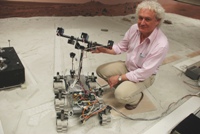Life on Mars?

Dr Dave Barnes with the ExoMars Rover at Aberystwyth
25 February 2008
Life on Mars?
December 25 2003 was meant to be a triumphant climax to the British Mars mission: the date when Beagle 2 was scheduled to touch down on the red planet. In the event, the mission ended in frustration and disappointment when all contact with the craft was lost.
Computer scientists at Aberystwyth University had played an important part in the enterprise, calibrating, simulating, and generating the high-level commands for the robotic arm that was to be instrumental in gathering data for analysis.
Dr Dave Barnes led the team at Aberystwyth that had worked for years on the project. “Not the best Christmas day I've had,” remembers Dr Barnes, but although the Beagle's failure was a blow to all concerned, the years of preparation and hard work were not in vain.
Beagle 2’s legacy is the expertise that was built up over the course of the project, and many of its features have been included in the European Mars mission, ExoMars 2013, which plans to send a Rover vehicle to Mars in 2013 to gather data that will help scientists answer the perennial question: Is there life on Mars?
ExoMars is an ESA Aurora Flagship mission involving 14 nations whose aim is to characterise the biological environment on Mars in preparation for robotic missions and then human exploration. Data from the mission will also provide invaluable input for broader searches for life on other planets.
Dr Barnes and his team are now playing an important role in preparing the rover vehicle, and Beagle 2’s robotic arm, which had five moving joints, is evolving into a more sophisticated arm which will be capable of much more demanding tasks.
Work is currently underway on developing a method of data gathering that will significantly reduce the time it will take the arm to place sensors and instruments on the Martian rocks. Under the Beagle 2 system, all commands for moving the arm had to be sent directly from earth but the Science and Technologies Facilities Council (STFC) together with EADS Astrium Ltd. is now funding work that will enable the arm to work in concert with on-board cameras and acquire samples autonomously.
In their laboratory in Aberystwyth, Dr Barnes and his team have a scale model of the rover vehicle set in a Martian landscape on a mixture of quartz sand and olivine which simulates the geophysical features of Martian soil. Here they are fine-tuning their calculations and computer simulations ready for the next phase of the mission which will see the different elements coming together.
The team is working to a tight deadline – the craft has to be launched in 2013 and will arrive at the planet towards the end of 2014. Once on the surface there will be an intensive six-month period of gathering data, and also from beneath the surface by drilling down 2 metres for samples.
Dr Barnes is convinced that if it were not for Beagle 2, the outlook for the ExoMars mission would not be so promising: “The work done for Beagle 2 has certainly informed the research for ExoMars, and although there’s a long way to go, we are now focused on achieving a successful mission in 2013.”



